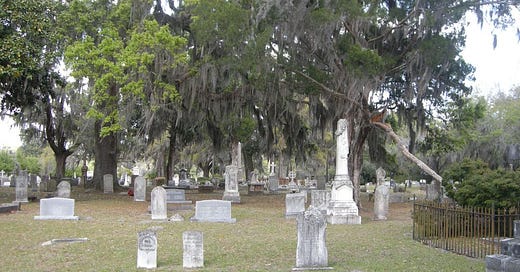The “cemetery episode”1 - as biographer Michael Gannon called it - took place in Savannah, Georgia beginning in March 1865 - three months after Sherman’s march through the city and four weeks before Lee surrendered to Grant at Appomattox.
It was a totally unnecessary desecration of the Catholic cemetery in that city.
The cemetery - St. Vincent de Paul Cemetery, known popularly as Cathedral Cemetery - served as the encampment area for some of General Sherman's troops after the surrender of the city on November 23, 1864.
Prior to Sherman’s march into Savannah, Confederate troops had built Fort Brown next to the cemetery, but after the city fell, Union engineers laid out a different defense line to protect against avenging rebel forces - though none existed - a project which removed cemetery fences.
Catholic citizens of the city were advised to rescue their dead while they could.2 The Sisters of Mercy, with the assistance of local women, rescued the remains of two bishops, two priests, and four sisters.
During the construction of the new fortress several graves were desecrated by Union troops.
A shocked Bishop Augustin Verot wrote in vehement protest to Secretary of War Edwin Stanton. Verot concluded his scathing letter by writing:
“It is hard to see how such a military necessity should have arisen so suddenly, now that there is no opposing force at all, and that the Confederates, far from being able to attack, evacuate everywhere what they had.
“I thought I could do no less than send my humble protest on behalf of the Catholic Church whose right and privileges I deem to be infringed by this proceeding; in behalf of an outraged community obliged now to carry away where they can the mouldering remains of their relatives and friends; in behalf of the (Union) Irish-Catholic soldiers who are obliged to perform the work of hyenas; and in behalf of those who will have to stand in the midst of exhalations arising from opened and mutilated graves.”
Stanton was offended, telling his Inspector General, Major James Hardie (a Catholic) to advise Verot he did not appreciate “the disrespectful and unbecoming language” of his protest letter, but to go ahead and make a full investigation of “his bitter complaint.”3
Sadly, Hardie’s inspection found that the disinterment of bodies had already been completed.
It wasn’t until 1867, after the relentless Bishop Verot urged President Andrew Johnson to restore the Cemetery to its former state, that they were reinterred.
The ‘‘cemetery episode” is but one chapter of the extraordinary story of these sacred burial grounds. A brief history, and the ongoing efforts at preservation, of Savannah’s Catholic cemetery can be found on the diocesan website here.
Biographer Michael Gannon uses this phrase in Rebel Bishop: The Life and Era of Augustin Verot (Bruce Pub, 1964).
Ibid., 110.
Ibid, 111.




